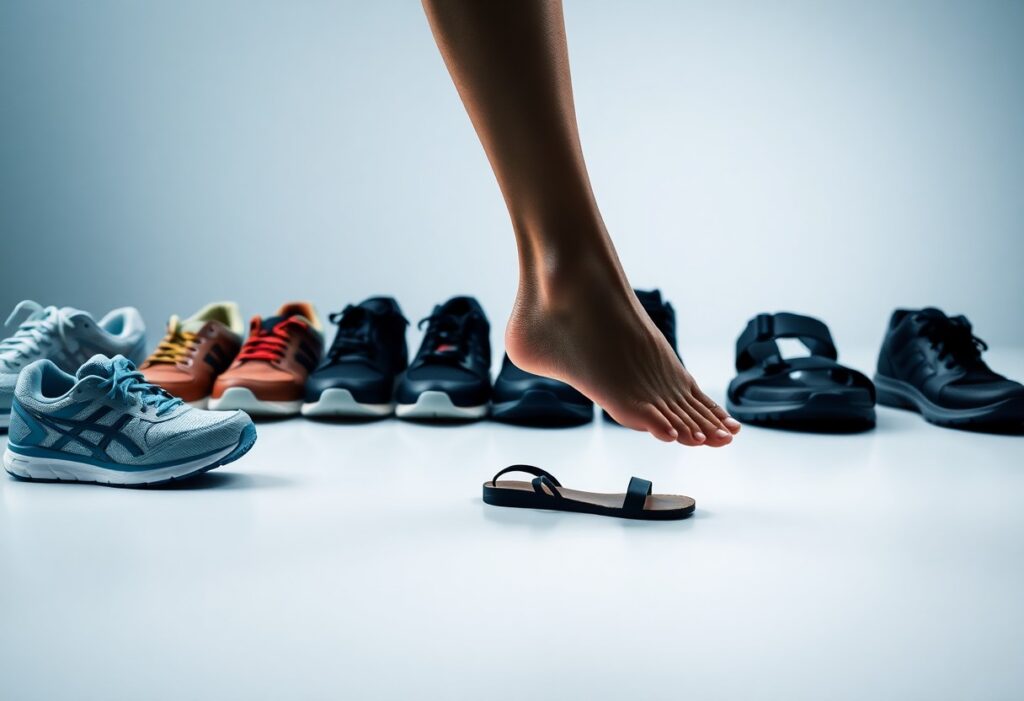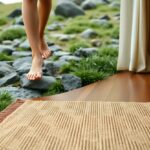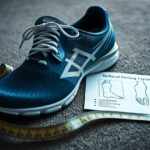
As you traverse through your day, the footwear you select can profoundly influence your foot health. Many people mistakenly think that shoes with more cushioning and support are the ultimate remedy for foot pain; however, conventional footwear often causes more harm than good. Dr. Alissa Kuizinas, a seasoned podiatrist from Massachusetts, champions the use of barefoot shoes or minimalistic shoes, arguing that they can strengthen your feet and promote overall wellness. By choosing footwear that allows your feet to function naturally, you can significantly reduce the risk of developing foot problems and improve your overall foot health.
Discovering the Hidden Dangers of Conventional Shoe Choices
While conventional shoes might provide temporary relief from foot pain, they frequently exacerbate existing conditions and introduce new problems, as highlighted by Dr. Alissa Kuizinas. She points out that the $133 billion shoe industry often emphasizes aesthetics and profit over genuine foot health, leading to designs that can restrict and weaken your feet over time. This reliance on traditional footwear can create a cycle of dependence that ultimately jeopardizes your foot health and well-being.
Uncovering the Shoe Industry's Flawed Approach to Foot Health
The root of this issue lies in the shoe industry’s flawed perspective on foot health, which typically emphasizes adding excessive cushioning, support, and rigidity in footwear without addressing the fundamental causes of discomfort. This approach can cultivate a dependency on shoes that may inadvertently harm your foot health over time, leading to a range of complications that could have been prevented with a more thoughtful design.
Evaluating the Shortcomings of Traditional Shoe Design
Many traditional shoe designs incorporate narrow toe boxes, stiff soles, and excessive cushioning that can restrict natural foot movement, resulting in weak and dysfunctional feet. Dr. Kuizinas argues that footwear should protect your feet from external elements while not limiting their natural motion. An ideal shoe design prioritizes natural foot function and includes minimalist characteristics like wide toe boxes, flexible and flat soles, and minimal cushioning to promote foot health effectively.
By opting for barefoot shoes or minimalistic footwear, you can actively enhance your foot strength and overall well-being. Dr. Kuizinas encourages a philosophy of using as little shoe as possible, allowing your feet to function naturally and move freely, which is essential for maintaining healthy foot mechanics and preventing future issues.
The Essential Importance of Unrestricted Foot Movement
Footwear that limits your foot's ability to move freely can result in numerous foot issues and discomfort. Evaluating the impact of your shoe choices on your overall foot health and comfort levels is crucial for long-term well-being.
Investigating How Shoes Affect Foot Mobility
To truly understand how shoes influence your foot's mobility, it's vital to examine the specific designs and features of your footwear. Traditional shoes often incorporate cushioning and support elements that can inadvertently hinder your foot's natural movement, leading to weak and dysfunctional feet over time. This restriction can inhibit your feet from developing the necessary strength and flexibility, which are essential for overall foot health.
Reaping the Benefits of Natural Foot Mobility
The benefits of allowing your feet to move naturally are vast, as strong feet form the foundation of overall foot health. By selecting minimalistic shoes or barefoot footwear, you empower your feet to perform as intended, promoting strength and resilience.
Movement is critical for developing robust feet. When confined by traditional footwear, you risk facing various foot problems and discomfort. In contrast, adopting minimalistic shoes or barefoot alternatives can greatly improve your foot health by allowing natural movement and facilitating strength-building. By making informed footwear choices, you can reduce your risk of developing foot issues and enhance your overall foot wellness.
Delving into the Principles of Functional Footwear
Understanding functional footwear is vital, as these shoes prioritize both foot health and natural movement. Functional shoes are specifically crafted to allow your feet to operate as they were designed, eliminating the need for excessive support or confinement.
Characterizing Functional Shoes and Their Distinct Features
After researching and trying different shoe styles, you will find that functional footwear possesses distinctive characteristics, including a wide toe box, flat and flexible soles, and minimal cushioning and support. These features enable your feet to move freely and naturally, fostering stronger and more effective foot mechanics.
The Positive Impact of Functional Shoes on Foot Health
Wearing functional shoes provides several benefits, such as improved foot strength, decreased risk of injury, and enhanced overall foot health. These shoes allow your feet to function as intended, paving the way for stronger feet and better balance in your everyday activities.
Conceptually, functional footwear is designed to support your feet without imposing unnecessary restrictions, allowing them to move and flex in a natural manner. This design ethos promotes optimal foot health and minimizes the chances of developing foot ailments. By selecting functional shoes like barefoot shoes or minimalistic options, you actively foster healthy foot function and reduce the risk of foot pain and injury. Transitioning to functional footwear may require gradual adjustments and patience, but the long-term benefits for your foot health are immeasurable.
Recognizing Key Features of Functional Footwear
To achieve optimal foot health, it's imperative to seek out shoes that possess specific features. The essential characteristics to consider include:
- Wide toe box
- Flat and flexible soles
- Minimal cushioning and support
Being aware of these attributes will significantly assist you in choosing shoes that promote healthy foot function and support.
Understanding the Significance of Wide Toe Boxes and Flexible Soles
A vital component of functional shoes is a wide toe box, which allows your toes to spread naturally. This design feature helps prevent toe jamming and other discomfort-related problems that could lead to chronic foot pain.
Recognizing the Importance of Minimal Cushioning and Support
In addition to a wide toe box, functional shoes should also offer minimal cushioning and support. This design principle enables your feet to move naturally while strengthening the muscles within, reducing the risk of foot issues.
It is crucial to emphasize that minimalistic footwear, including barefoot shoes, can significantly enhance your foot health by allowing your feet to function freely. By choosing shoes with minimal cushioning and support, you can increase the muscular strength in your feet and decrease the likelihood of injuries. This strategic choice not only improves your overall foot health but also reduces the risk of experiencing chronic pain. Therefore, prioritize footwear that allows your feet to move naturally without excessive cushioning or support.
Embarking on the Journey to Functional Footwear
Having acknowledged the significance of functional footwear, it's time to initiate your transition. Contrary to the prevalent belief that more cushioning and support leads to better comfort, you should opt for minimalistic shoes or barefoot shoes that facilitate your feet's natural functioning.
Actionable Tips for Transitioning to Functional Footwear
Despite any initial hesitations, start integrating functional shoes into your daily routine with these practical suggestions:
- Begin with short walks and gradually increase the distance
- Choose shoes with a wide toe box and flat soles
- Prefer minimal cushioning and support
The key is to give your feet time to adjust to the new footwear while simultaneously strengthening the muscles in your feet.
Highlighting the Necessity for Patience and Gradual Adjustment
Transitioning to functional footwear requires patience and a gradual approach. Shoes that are overly minimalist can cause discomfort and pain if your feet are not accustomed to them. Taking it slow is essential, allowing your feet to acclimate to the new shoes.
Footwear choices like barefoot shoes or minimalistic shoes can be incredibly beneficial for your foot health, but it's crucial to introduce them gradually. Overuse or improper sizing can lead to injuries or persistent discomfort. The ultimate aim is to strengthen your foot muscles while enhancing your overall foot health, so exercise patience and refrain from rushing the process. The benefits will be substantial; anticipate experiencing improved balance, less pain, and stronger feet.
Fostering Strong and Functional Feet for Lifelong Health
Even in an era where shoes with excessive cushioning and support are prevalent, you can cultivate strong and functional feet by making informed footwear choices.
Recognizing the Influence of Foot Strength on Overall Well-Being
Foot strength is a critical factor in your overall health, affecting your balance, posture, and movement capabilities in conjunction with other health aspects.
How Functional Footwear Supports the Development of Strong Feet
Functionally designed shoes that include a wide toe box, flat and flexible soles, and minimal cushioning are essential for developing strong feet, as they facilitate natural movement.
Indeed, wearing functional shoes or barefoot shoes can significantly contribute to building stronger foot muscles and improving your overall foot health. By allowing your feet the freedom to move and function naturally, you can reduce the risk of foot problems and enhance your balance and stability. As you transition to minimalistic shoes, you should expect to see enhancements in your walking technique and your overall sense of well-being.
By taking proactive steps to manage your foot health, you can select shoes that enhance your feet's natural functions rather than obstruct them. Choosing barefoot shoes or minimalistic options that permit your feet to operate naturally will aid in strength development over time. By doing so, you'll benefit from increased stability and comfort during various activities, enabling your feet to become strong and capable. Start your journey by seeking shoes that feature a wide toe box, flat and flexible soles, and minimal cushioning and support, while exercising patience as you transition to a more natural walking style.
The Article A Podiatrist’s Guide to How Shoes Affect Your Foot Health appeared first on My Shoes Finder
The Article How Shoes Impact Your Foot Health: A Podiatrist’s Insights Was Found On https://limitsofstrategy.com








Comments are closed